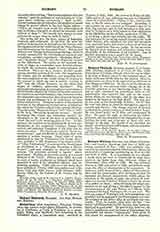

Richard Whiting, BLESSED, last Abbot of Glastonbury and martyr, parentage and date of birth unknown, executed November 15, 1539; was probably educated in the claustral school at Glastonbury, whence he proceeded to Cambridge, graduating as M.A. in 1483 and D.D. in 1505. If, as is probable, he was already a monk when he went to Cambridge he must have received the habit from John Selwood, Abbot of Glastonbury from 1456 to 1493. He was ordained deacon in 1500 and priest in 1501, and held for some years the office of chamberlain of his monastery. In February, 1525, Richard Bere, Abbot of Glastonbury, died, and the community, after deciding to elect his successor per formam compromissi, which places the selection in the hands of some one person of note, agreed to request Cardinal Wolsey to make the choice of an abbot for them. After obtaining the king’s permission to act and giving a fortnight’s inquiry to the circumstances of the case Wolsey on March 3, 1525, nominated Richard Whiting to the vacant post. The first ten years of Whiting’s rule were prosperous and peaceful, and he appears in the State papers as a careful overseer of his abbey alike in spirituals and ternporals. Then, in August, 1535, came the first “visitation” of Glastonbury by Dr. Layton, who, however, found all in good order. In spite of this, however, the abbot’s jurisdiction over the town of Glastonbury was suspended and minute “injunctions” were given to him about the management of the abbey property; but then and more than once during the next few years he was assured chat there was no intention of suppressing the abbey.
By January, 1539, Glastonbury was the only monastery left in Somerset, and on September 19 in that year the royal commissioners, Layton, Pollard and Moyle, arrived there without warning. Whiting happened to be at his manor of Sharpham. Thither the commissioners followed and examined him according to certain articles received from Cromwell, which apparently dealt with the question of the succession to the throne. The abbot was then taken back to Glastonbury and thence sent up to London to the Tower that Cromwell might examine him for himself but the precise charge on which he was arrested, and subsequently executed, remains uncertain though his case is usually referred to as one of treason. On October 2, the commissioners wrote to Cromwell that they had now come to the knowledge of “divers and sundry treasons committed by the Abbot of Glastonbury”, and enclosed a “book” of evidences thereof with the accusers’ names, which however is no longer forthcoming. In Cromwell’s MS., “Remembrances”, for the same month, are the entries: “Item, Certayn persons to be sent to the Towre for the further examenacyon of the Abbot of Glaston Item. The Abbot of Glaston to (be) tryed at Glaston and also executyd there with his complycys… Item. Councillors to give evidence against the Abbot of Glaston, Rich. Pollard, Lewis Forstew (Forstell), Thos. Moyle.” Marillac, the French Ambassador, on October 25 wrote: “The abbot of Glastonbury has lately been put in the Tower, because, in taking the Abbey treasures, valued at 200,000 crowns, they found a written book of arguments in behalf of queen Katherine.” If the charge was high treason, which appears most probable, then, as a member of the House of Peers, Whiting should have been attainted by an Act of Parliament passed for the purpose, but his execution was an accomplished fact before Parliament even met. In fact it seems clear that his doom was deliberately wrapped in obscurity by Cromwell and Henry, for Marillac, writing to Francis I on November 30, after mentioning the execution of the Abbots of Reading and Glastonbury, adds: “could learn no particulars of what they were charged with, except that it was the relics of the late lord marquis”; which makes things more perplexing than ever. Whatever the charge, however, Whiting was sent back to Somerset in the care of Pollard and reached Wells on November 14. Here some sort of trial apparently took place, and next day, Saturday, November 15, he was taken to Glastonbury with two of his monks, Dom John Thorne and Dom Roger James, where all three were fastened upon hurdles and dragged by horses to the top of Tor Hill which overlooks the town. Here they were hanged, drawn and quartered, Abbot Whiting’s head being fastened over the gate of the now deserted abbey and his limbs exposed at Wells, Bath, Iichester and Bridgewater. Richard Whiting was beatified by Pope Leo XIII in his decree of May 13, 1895. His watch and seal are still preserved in the museum at Glastonbury.
G. ROGER HUDLESTON

